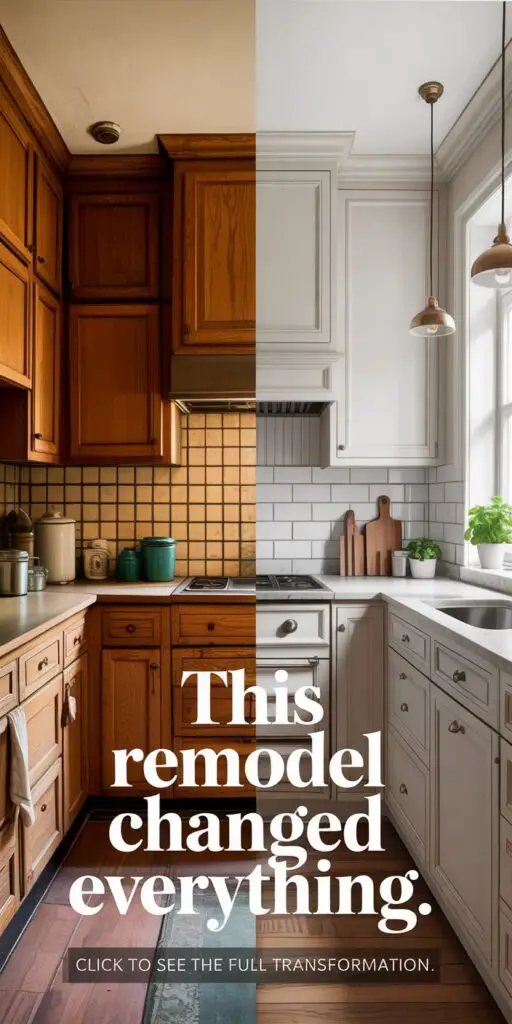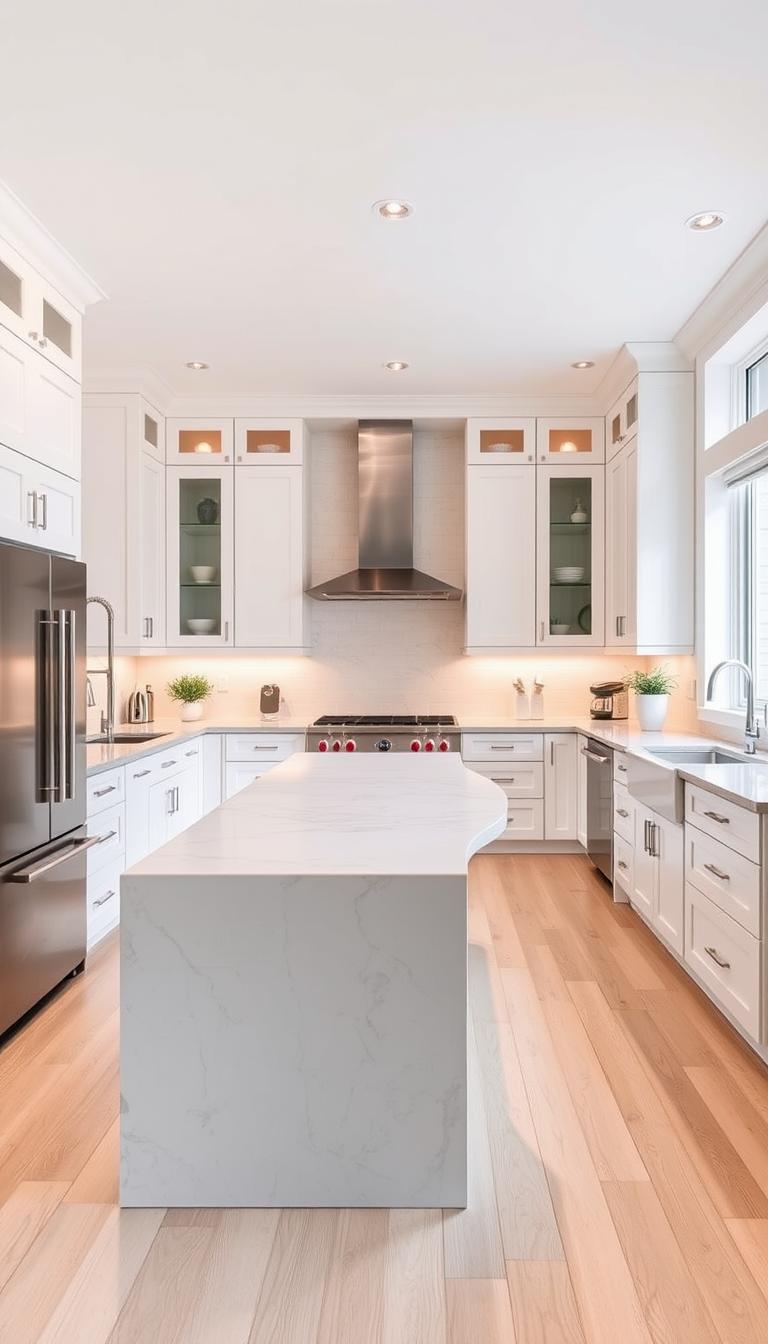I still remember my first attempt at redesigning the heart of our home. Excited but unprepared, I splurged on marble countertops—only to realize halfway through that my budget couldn’t cover the custom cabinets we needed. That lesson taught me the value of realistic planning.
A well-executed project balances beauty and function. Think pull-out spice racks for cluttered cooks or a cozy breakfast nook for family mornings. According to recent trends, over 70% of homeowners prioritize workflow efficiency—proof that smart design beats fleeting trends.
This guide will walk you through budgeting, spatial challenges, and material choices. Whether you’re craving a coffee bar or extra seating, every decision should serve your home’s rhythm. Let’s create a space that grows with you.
Key Takeaways
- Balance aesthetics with practical features like storage and seating.
- Set a clear budget, accounting for labor and material costs.
- Prioritize workflow efficiency for daily ease.
- Choose durable materials that fit your lifestyle.
- Plan for flexibility—your needs may evolve over time.
Start with a Realistic Kitchen Remodel Budget
Budgeting mistakes can turn a dream project into a financial headache—I learned this the hard way. A clear plan prevents overspending and keeps priorities in check. Here’s how to allocate funds wisely.
Redesign any interior in just 30 seconds with this powerful AI software tool—turn your wildest decor dreams into photorealistic visions instantly. Try it now and watch your space transform ... Try This FREE AI design tool.
Where Your Money Goes
Break costs into categories to avoid surprises. Cabinets often eat up 25–35% of budgets, while appliances take 15–20%. Here’s a snapshot:
| Category | Average Cost (%) | Tip |
|---|---|---|
| Cabinets | 25–35% | Refinish instead of replace |
| Appliances | 15–20% | Look for energy-efficient models |
| Countertops | 10–15% | Quartz balances cost and durability |
| Labor | 20–25% | Get 3+ quotes |
One client saved $8,000 by refinishing their cabinets. New doors and fresh paint gave them a high-end look for half the price.
“Buy in-stock materials to skip 6–8 week delays. Our Phoenix clients cut timelines by 30% this way.”
Prioritize and Protect
Split your list into must-haves (like plumbing fixes) and nice-to-haves (like pendant lighting). Always set aside 10–15% for hidden costs—think wiring upgrades or unexpected wall repairs.
Financing matters too. A HELOC might suit long-term owners, while cash keeps you debt-free. One Arizona family used a HELOC to fund their project, then paid it off with home-value gains.
Remember: A realistic budget is your blueprint for success. Plan for the worst, and you’ll enjoy the process—not dread it.
Choose the Right Kitchen Layout for Your Space
Ever bumped elbows with someone while cooking? I have—because my old galley-style setup felt cramped. The right floor plan makes daily tasks smoother, whether you’re hosting or just making coffee.
Galley, L-Shape, or Island: Pros and Cons
Each layout suits different needs. A galley design works best for narrow areas (10×12 ft or smaller). It keeps everything within reach but lacks seating. Here’s a quick comparison:
| Layout | Best For | Drawbacks |
|---|---|---|
| Galley | Small spaces, single cooks | No dining area |
| L-Shape | Corner spaces, open flow | Limited counter space |
| Island | Large families, prep space | Needs 42″ clearance |
One Denver couple added a peninsula to split cooking and dining zones. It gave them extra seating without sacrificing workflow.
How to Maximize Small Spaces
Even tight areas can feel spacious. Use these hacks:
- Narrow pull-outs: 14″ deep cabinets fit spices or pans.
- Vertical storage: Floor-to-ceiling shelves free up counters.
- Light colors: White or pale gray visually expand the area.
“Islands increase prep space by 40%, but budget $4K–$12K extra for plumbing and materials.”
I once installed an oversized island that blocked the fridge. Measure twice—your future self will thank you.
Redesign any interior in just 30 seconds with this powerful AI software tool—turn your wildest decor dreams into photorealistic visions instantly. Try it now and watch your space transform ... Try This FREE AI design tool.
Pick a Design Style That Matches Your Home
My friend’s all-black modern space looked stunning—until she tried selling her home. Buyers called it “too niche,” proving that timeless design often wins over fleeting trends. Here’s how to balance personality with broad appeal.
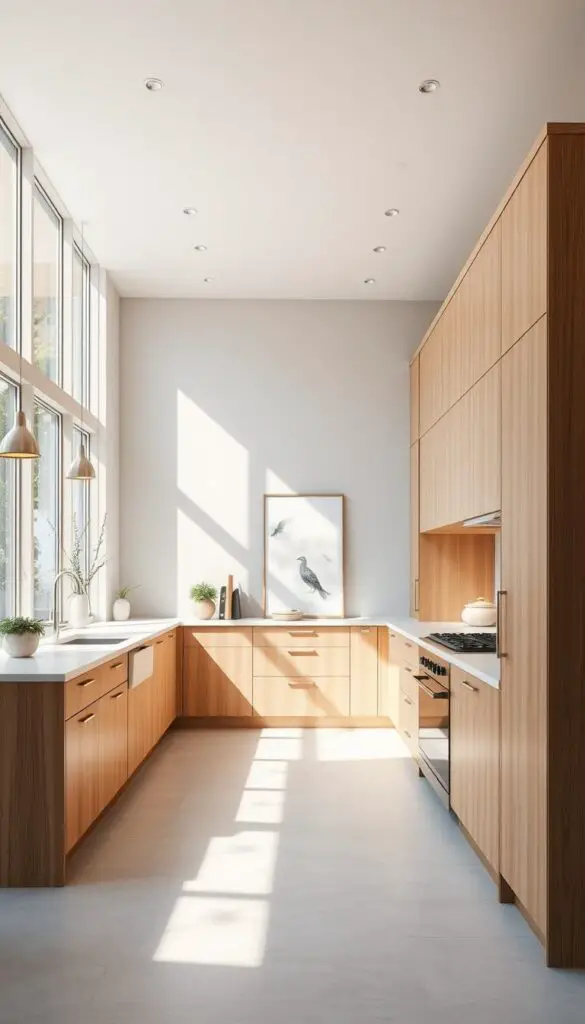
Timeless vs. Trendy: Balancing Aesthetics
2024 NAR data shows neutral spaces resell 23% faster. But bold backsplashes dominate Instagram. The sweet spot? A transitional style—like Shaker cabinets with zellige tile and brass hardware.
Avoid over-customization. Remember avocado green appliances from the 1970s? They’re now costly to replace. Instead:
- Mix classic and current: Quartz counters with wood-grained islands (as designer Amanda Reynal suggests).
- Limit statement pieces: One bold element (e.g., a patterned tile wall) keeps updates affordable.
Color Schemes That Elevate Your Space
Color psychology matters. Blues may suppress appetite—use them sparingly. Warm whites, though, boost resale value. A Portland home nailed it with navy lower cabinets and white uppers.
“Test large paint swatches at 10 AM, 3 PM, and dusk. Lighting changes everything.”
Pro tip: Matte finishes on cabinets hide fingerprints, while glossy backsplashes reflect light. Your design should work as hard as it looks.
Select Durable and Stylish Materials
A client once replaced their countertops three times—proof that material choices matter. The right picks blend beauty with resilience, saving you from costly do-overs. Let’s explore options that stand the test of time.
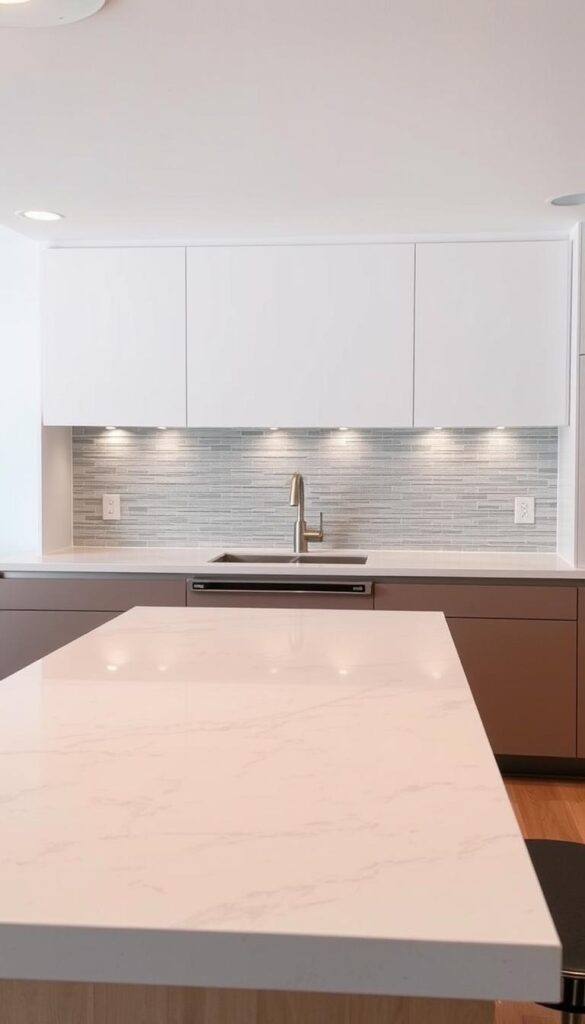
Countertops: Quartz, Granite, or Butcherblock?
Quartz resists stains and heat, ideal for busy homes. At $70–$100/sqft, it’s pricier than butcherblock ($40/sqft) but needs zero sealing. Granite? Modern sealants debunk the “high-maintenance” myth—just reseal yearly.
One Boston homeowner paired quartz counters with a wood-grained island. The mix offered warmth and practicality. Pro tip: Sample materials under your kitchen lighting—colors shift throughout the day.
Backsplash Ideas: Subway Tile vs. Bold Patterns
Classic subway tile costs 30% less than handmade options. For drama, try large-format porcelain slabs. A bold backsplash becomes the focal point, like the navy geometric pattern I installed in a Seattle loft.
“4×12″ tiles hide imperfections better than small mosaics—a lifesaver for DIYers.”
Flooring Options: Wood, Tile, or Performance Materials
Hardwood lasts 100 years but dents easily. Porcelain tile works with underfloor heating, while LVT (luxury vinyl tile) mimics wood with a 20-year warranty. Avoid glossy dark tiles—they show every dust speck.
Matte finishes hide scratches in high-traffic areas. My pick? Engineered wood for warmth and scratch-resistant coatings.
Plan Your Kitchen Storage Solutions
Nothing kills cooking joy faster than rummaging through cluttered drawers—a lesson I learned after dropping my favorite skillet. Smart storage solutions save time and keep your space functional. Start by calculating needs: A family of four typically requires 12–15 linear feet of cabinetry.
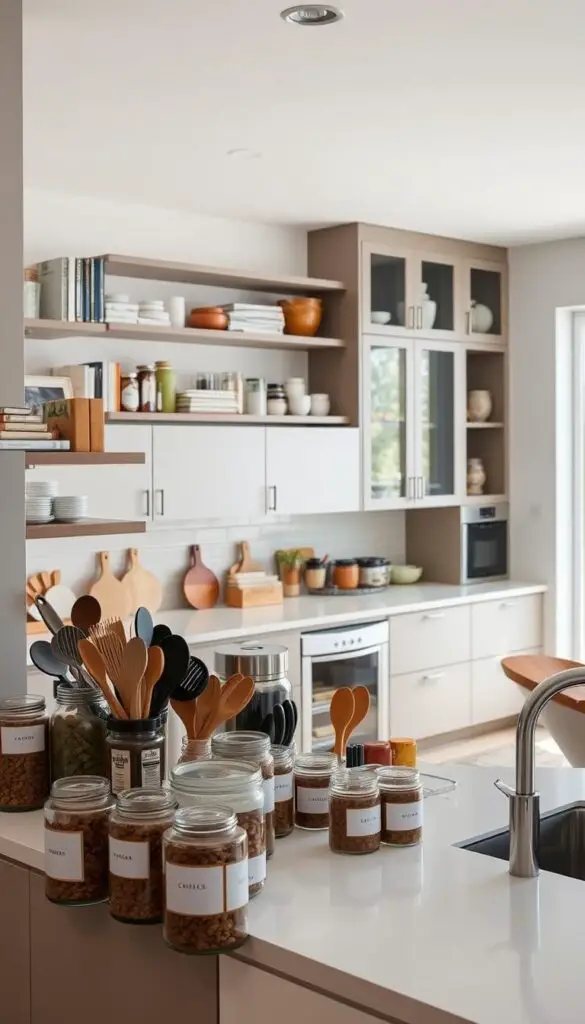
Glass Fronts vs. Opaque Doors
Glass-front cabinets ($120/door) showcase dishes but demand tidiness. Solid doors ($85) hide chaos but can feel closed-off. Designer Amanda Reynal often mixes both—glass uppers for display, opaque lowers for practicality.
For a high-end look, try interiors with vertical dividers. A 24″ pull-out pantry holds 50+ canned goods, while toe-kick drawers (like in a NYC apartment) stash baking sheets discreetly.
Hidden Hacks for Clutter-Free Counters
Steal my favorite trick: Install tray dividers beside the oven. They corral cutting boards without eating counter area. Other wins:
- Lower drawers for plates—no more stacking.
- Spice racks inside cabinet doors (saves 30% of shelf space).
- Magnetic strips under upper cabinets for knives.
“Over-accessorizing drawers wastes space. Test hardware samples with your pots before committing.”
Remember: Your design should work as hard as you do. Every inch counts when crafting a seamless flow.
Lighting and Functional Details
The first time I flipped on my new ultra-bright LEDs, I realized lighting makes or breaks a space. A well-lit room feels inviting, while harsh beams can turn dinner prep into a clinical chore. Here’s how to blend beauty and function.
- 50% ambient: Ceiling fixtures or recessed lights for overall brightness.
- 30% task: Under-cabinet strips to illuminate chopping boards.
- 20% accent: Pendants over islands for a cozy glow.
Dimmable LEDs (2700K color temperature) are my top pick. They mimic natural light and save energy. One client’s hospital-style fixtures made their marinara look dull—switching to warm LEDs fixed it instantly.
“Calculate wattage by multiplying your room’s square footage by 1.5. A 100 sqft area needs 150 watts total.”
Place decorative sconces by windows to eliminate shadows. LED strips use 80% less power than halogens, cutting bills without sacrificing style. Remember: Lighting isn’t just functional—it’s the finish that ties your design together.
Install Appliances and Hardware Last
A client once dented their brand-new fridge because they rushed the installation sequence. Appliances should always go in after cabinets—this prevents dings and simplifies adjustments. I schedule deliveries two weeks post-cabinet install to avoid chaos.
Panel-ready appliances ($8K+) offer a built-in look, but standard models ($2.5K) work if you’re budget-conscious. One homeowner saved $4K by choosing stainless steel instead of custom panels—without sacrificing style.
Never mount hardware early. A client’s brass handles got paint splatter during touch-ups, forcing a reorder. Wait until walls and cabinets have their final finish.
“Use temporary plywood countertops during appliance fitting. They protect surfaces and cost under $50.”
Gas ranges need 3/4″ lines—check local codes before hookups. For smart upgrades, Wi-Fi ovens signal when preheating’s done. These small details save time and stress in the long run.
Patience pays off in the final project phase. Measure twice, install once, and enjoy a seamless finish.
Avoid Common Kitchen Remodel Mistakes
A shattered glass backsplash taught me the importance of planning for accidents. One client’s trendy tile cracked during a range installation—costing $1,200 to replace. Small oversights like this add up fast.
Overlooking Workflow and Traffic Patterns
NKBA surveys show 63% of renovators regret poor workflow planning. The old “work triangle” rule (sink-fridge-stove) is outdated. Modern layouts need zones—prep, cooking, and cleanup areas—with clear pathways.
For example, a retired couple added knee-space under their island for seated prep. They kept 36″ walkways for walkers, proving universal design matters at every life stage.
Forgetting to Future-Proof Your Design
Trends fade, but quality lasts. Quartz counters outperform terrazzo in durability, while soft-close cabinets outlive exposed rails. Lever handles (not knobs) aid arthritic hands—a smart choice for aging in place.
“Open shelves demand daily curation. Glass-front uppers show clutter unless you’re meticulous.”
Plan for evolving needs. A family I worked with chose neutral floor tones to blend with future home styles. Their space still feels fresh a decade later.
Conclusion
Sunday breakfasts transformed once we nailed the layout—proof good planning matters. A successful project balances immediate needs with long-term flexibility. Start small: refresh countertops now, update cabinets later.
Live with painter’s tape outlines for a week before demo. As designer Amanda Reynal says, “Design for how you cook, not HGTV.” One client’s testimonial says it all: “Our functional space finally fits our family’s pancake rituals!”
Ready to begin? Download our free kitchen checklist with budget templates. Whether it’s a full remodel or subtle tweaks, let your home’s heart work smarter for you.
